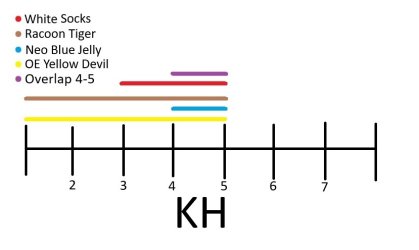abandon_ship
New Member
Pardon the novel...
I've had a thought on how to incorporate multiple species of shrimp into one habitat so that one could get a "skittles" effect, without cross breeding. This would lead to longevity of pure strains in the tank and in theory reduce culls. Ideally, shrimps would be healthy and able to reproduce. Information on parameters is all over the place with different breeders doing what works for them. I've included citations to breeder pages I've gathered data from. There do seem to be some overlaps that could work with a few caveats. Below I will go into detail on my findings and extrapolations I've made.
OE Yellow Devils (Caridina cantonensis)
-Possible cross between OEBT (Tiger) and Yellow KK (Tibee)
-Yellow King Kong is described as one of the more hardy Caridinas
-Orange Eye Blue Tigers have been kept in Neo parameters. Therefore with the possible heavy tiger influence, I've theorized their parameters closer to that of a OEBT.
Neo Blue Jellies (Neocaridina davidi)
-Bred from Blue Rili
-Possibly slightly less hardy than other Neos
Racoon Tiger (Caridina mariae)
-This may not be the species for the parameters I've listed
-Hardy Cardina and bred in Neo parameters
-One of the more hardy Sulawesi
-Some breeders say stability is more important than strict parameters
-Expanded parameters in graphs based on parameters of Snow Zebra Suluwesi
-The most obvious issue will be the gap between the other Caridinas listed and the Sulawesi
-Strains will be bred under different breeder conditions and may not acclimate as theorized
-Overlaps for some parameters would push species to extreme end of water parameters
-Expansion of parameters for Sulawesi White Socks may be exaggerated on my part
-Assumption of OE Yellow Devil parameters may be exaggerated on my part
-Over-crowding and crashes due to different shrimp breeding speeds and diets
Conclusion:
I would like to hear from those of you in the shrimp community that have kept any of the mentioned varieties in more "extreme" water parameters (especially lower temps for Sulawesi or higher temps for Caridina). Below I've graphed my finding and assumptions for ease of comparison.





I've had a thought on how to incorporate multiple species of shrimp into one habitat so that one could get a "skittles" effect, without cross breeding. This would lead to longevity of pure strains in the tank and in theory reduce culls. Ideally, shrimps would be healthy and able to reproduce. Information on parameters is all over the place with different breeders doing what works for them. I've included citations to breeder pages I've gathered data from. There do seem to be some overlaps that could work with a few caveats. Below I will go into detail on my findings and extrapolations I've made.
OE Yellow Devils (Caridina cantonensis)
-Possible cross between OEBT (Tiger) and Yellow KK (Tibee)
-Yellow King Kong is described as one of the more hardy Caridinas
-Orange Eye Blue Tigers have been kept in Neo parameters. Therefore with the possible heavy tiger influence, I've theorized their parameters closer to that of a OEBT.
- Temperature: 66–72°F
- pH: 6 – 7.4
- kH (Carbonate Hardness): 0–5 dKH
- gH (General Hardness): 4–12 dGH
- TDS (Total Dissolved Solids): 200-300
- Parameter Source: Shrimp Ambition (OEBT)
Neo Blue Jellies (Neocaridina davidi)
-Bred from Blue Rili
-Possibly slightly less hardy than other Neos
- Temperature: 65–85°F, but they do best in the mid to upper 70s
- pH: 7 – 7.6
- kH (Carbonate Hardness): 4–5 dKH
- gH (General Hardness): 7–12 dGH
- TDS (Total Dissolved Solids): 200-300
- Parameter Source: Shrimp Ambition (Neo Blue Jelly)
Racoon Tiger (Caridina mariae)
-This may not be the species for the parameters I've listed
-Hardy Cardina and bred in Neo parameters
- Temperature: 66–72°F
- pH: 6 – 7.4
- kH (Carbonate Hardness): 0–5 dKH
- gH (General Hardness): 4–12 dGH
- TDS (Total Dissolved Solids): 200-300
- Parameter Source: Shrimp Ambition (Racoon Tiger)
-One of the more hardy Sulawesi
-Some breeders say stability is more important than strict parameters
-Expanded parameters in graphs based on parameters of Snow Zebra Suluwesi
- Temperature: 78-85°F
- pH: 7.5-8
- KH(Carbonate Hardness): 4
- GH:(General Hardness): 6
- TDS (Total Dissolved Solids): 125
- Parameter Source: Shrimply Fintastic (Sulawesi White Sock) and Shrimp Ambition (Snow Zebra Suluwesi)
-The most obvious issue will be the gap between the other Caridinas listed and the Sulawesi
-Strains will be bred under different breeder conditions and may not acclimate as theorized
-Overlaps for some parameters would push species to extreme end of water parameters
-Expansion of parameters for Sulawesi White Socks may be exaggerated on my part
-Assumption of OE Yellow Devil parameters may be exaggerated on my part
-Over-crowding and crashes due to different shrimp breeding speeds and diets
Conclusion:
I would like to hear from those of you in the shrimp community that have kept any of the mentioned varieties in more "extreme" water parameters (especially lower temps for Sulawesi or higher temps for Caridina). Below I've graphed my finding and assumptions for ease of comparison.




